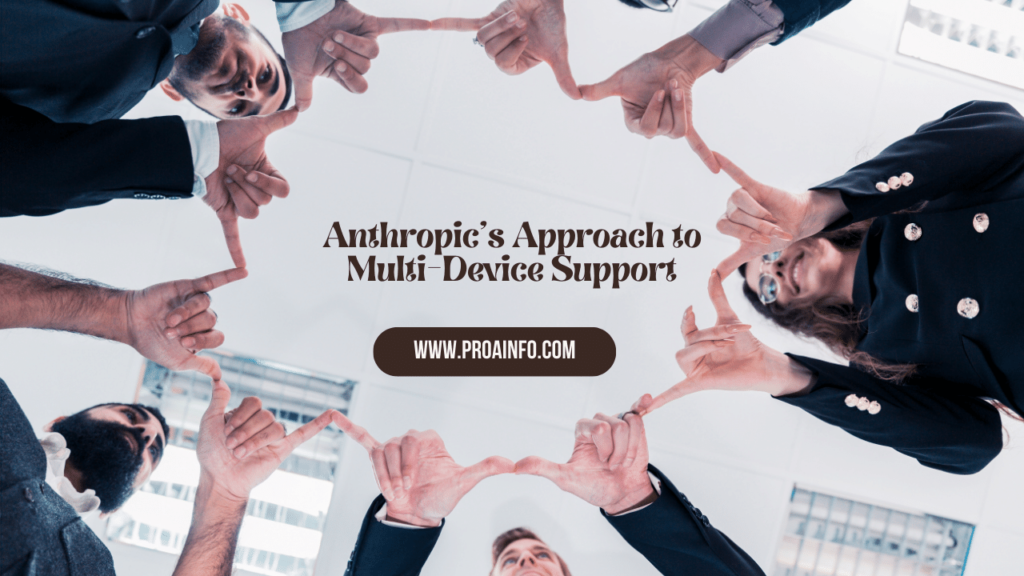Can Claude 3 be used on multiple devices? In today’s world, where technology has become an integral part of our lives, we heavily rely on artificial intelligence (AI) assistants like Claude 3 to simplify various tasks. These AI assistants have proven to be invaluable tools, assisting us with everything from writing and research to coding and data analysis.
However, as our dependence on these assistants grows, so does the need for flexibility and accessibility across multiple devices. This article delves into the fascinating world of Claude 3, exploring its capabilities and answering the burning question: Can Claude 3 be used on multiple devices?
What is Claude 3?

Before we dive into the intricacies of device compatibility, let’s first understand what Claude 3 is. Claude 3 is an advanced language model developed by Anthropic, a leading AI research company. It is a powerful AI assistant capable of engaging in natural language conversations, understanding and interpreting complex queries, and providing insightful and well-reasoned responses.
Claude 3 is built on a foundation of cutting-edge machine learning techniques, including transformer architectures and unsupervised pre-training on vast amounts of data. This allows it to grasp nuanced contextual information, making it an exceptional tool for various tasks, including writing, analysis, coding, and problem-solving.
The Evolution of AI Assistants
AI assistants have come a long way since their inception. Initially, these assistants were designed to operate on specific devices or platforms, limiting their accessibility and usability. However, as technology has advanced, the demand for seamless integration across multiple devices has become increasingly crucial.
Imagine the convenience of being able to seamlessly transition your conversation with Claude 3 from your desktop computer to your smartphone or tablet, without losing any context or disrupting your workflow. This level of accessibility not only enhances productivity but also fosters a more natural and intuitive user experience.
Multi-Device Compatibility: The Key to Convenience
One of the primary advantages of using Claude 3 is its potential for multi-device compatibility. By leveraging cloud computing and advanced synchronization technologies, Claude 3 can be accessed from various devices, ensuring a consistent and uninterrupted experience.
This level of flexibility is particularly beneficial for individuals who frequently work across multiple devices, such as professionals who split their time between the office and home, or students who transition between their laptops, tablets, and smartphones. With Claude 3’s multi-device compatibility, users can seamlessly pick up where they left off, regardless of the device they’re using.
Anthropic’s Approach to Multi-Device Support

Anthropic, the company behind Claude 3, recognizes the increasing demand for AI assistants that can adapt to our ever-changing technological landscape. As a result, they have made multi-device compatibility a key priority in the development and deployment of Claude 3.
One approach Anthropic has taken is to leverage cloud-based infrastructure, allowing Claude 3 to be accessed from any device with an internet connection. This cloud-based architecture ensures that users can access the same instance of Claude 3 across multiple devices, maintaining the continuity of conversations and project-specific contexts.
Another aspect of Anthropic’s strategy is the implementation of robust security measures to protect user data and ensure privacy. With the potential for sensitive information to be shared with Claude 3, it is crucial that this data remains secure and inaccessible to unauthorized parties, regardless of the device being used.
Overcoming Challenges: Synchronization and Data Management
While the prospect of using Claude 3 on multiple devices is undoubtedly exciting, it also presents several challenges that must be addressed. One of the primary challenges is ensuring seamless synchronization across devices, ensuring that the AI assistant’s responses and contextual understanding remain consistent and up-to-date.
To overcome this challenge, Anthropic employs advanced synchronization techniques that enable real-time updates and data sharing across devices. This ensures that any changes or updates made to the conversation or project context on one device are immediately reflected on all other connected devices.
Another challenge lies in managing and storing the vast amounts of data generated by Claude 3’s interactions with users. This data includes conversation histories, project files, and any other relevant information that may be required for maintaining context and providing accurate responses.
Anthropic tackles this challenge by implementing robust data management strategies, leveraging cloud storage and advanced compression techniques to ensure efficient storage and retrieval of user data. Additionally, they employ advanced security measures, such as encryption and access controls, to safeguard user privacy and prevent unauthorized access to sensitive information.
Use Cases: Leveraging Claude 3 Across Devices
The ability to use Claude 3 on multiple devices opens up a world of possibilities and use cases across various industries and domains. Here are a few examples:
- Professional Collaboration Imagine a team of writers, researchers, or analysts working on a collaborative project. With Claude 3’s multi-device compatibility, team members can seamlessly contribute to the project from their respective devices, whether they’re in the office, at home, or on the go. Claude 3 can assist with research, writing, and analysis, ensuring consistency and continuity throughout the project’s lifecycle.
- Education and Learning Students and educators can greatly benefit from using Claude 3 across multiple devices. Whether working on assignments, conducting research, or engaging in online discussions, Claude 3 can provide valuable assistance and insights. With the ability to access the AI assistant from their laptops, tablets, or smartphones, students can leverage its capabilities whenever and wherever they need it.
- Personal Productivity For individuals seeking to enhance their personal productivity, Claude 3’s multi-device compatibility can be a game-changer. Whether you’re writing a novel, managing a household budget, or exploring new coding projects, Claude 3 can be your trusted companion across all your devices, providing support and guidance every step of the way.
- Accessibility and Inclusivity The ability to use Claude 3 on multiple devices can also contribute to greater accessibility and inclusivity. Individuals with diverse needs and preferences can choose the device that best suits their requirements, whether it’s a desktop computer, a smartphone, or a dedicated assistive technology device.
Integrating Claude 3 with Other Devices and Services
While the ability to use Claude 3 on multiple devices is a significant advantage, its true potential lies in seamless integration with other devices and services. Anthropic recognizes this need and is actively exploring ways to integrate Claude 3 with a wide range of third-party applications, platforms, and Internet of Things (IoT) devices.
Imagine being able to leverage Claude 3’s capabilities through your smart home assistant, seamlessly controlling your connected devices and automating various tasks. Or perhaps you’re a developer looking to integrate Claude 3 into your custom application, providing users with a powerful AI-driven experience tailored to their specific needs.
By fostering an ecosystem of integrations and partnerships, Anthropic aims to make Claude 3 a ubiquitous presence in our digital lives, enhancing productivity, efficiency, and convenience across a wide range of scenarios.
Privacy and Security Considerations
As with any technology that handles sensitive data and personal information, it is crucial to address privacy and security concerns when using Claude 3 across multiple devices. Anthropic has made it a top priority to implement robust security measures and adhere to industry-leading privacy standards.
One key aspect of Anthropic’s approach to privacy and security is the use of end-to-end encryption. This ensures that any data exchanged between Claude 3 and the user’s devices remains secure and inaccessible to unauthorized parties, even if intercepted.
Additionally, Anthropic employs strict access controls and authentication measures, ensuring that only authorized users can access and interact with Claude 3 on their respective devices. These measures help prevent unauthorized access and potential data breaches.
Anthropic also adheres to stringent data protection regulations, such as the General Data Protection Regulation (GDPR) and the California Consumer Privacy Act (CCPA), ensuring that user data is handled with the utmost care and in compliance with relevant privacy laws.
Furthermore, Anthropic provides users with transparency and control over their data. Users can access and manage their data, including conversation histories and project files, and have the option to delete or export this information as needed.
By prioritizing privacy and security, Anthropic aims to foster trust and confidence among users, enabling them to leverage Claude 3’s capabilities across multiple devices without compromising their personal information or sensitive data.
The Future of Multi-Device AI Assistants
The ability to use Claude 3 on multiple devices is just the beginning of a larger paradigm shift in the world of AI assistants. As technology continues to evolve, we can expect to see even more advanced and seamless integration across a wider range of devices and platforms.
One potential future development is the integration of AI assistants with wearable technology, such as smartwatches and augmented reality (AR) devices. Imagine being able to interact with Claude 3 through a heads-up display or voice commands, receiving real-time assistance and information without the need for a traditional computing device.
Another exciting possibility is the emergence of AI assistants that can adapt and learn from user preferences and behavior across multiple devices. Imagine if Claude 3 could analyze your interaction patterns, writing style, and preferences on one device and automatically apply that knowledge to enhance its performance on another device. This level of personalization and adaptability would create an even more seamless and intuitive user experience.
Moreover, as the Internet of Things (IoT) continues to expand, we can anticipate AI assistants like Claude 3 becoming integral components of smart homes and connected environments. By seamlessly integrating with various IoT devices, Claude 3 could potentially automate and optimize various aspects of our daily lives, from managing energy consumption to controlling home security systems and scheduling appointments.
The role of AI assistants in the realm of virtual and augmented reality (VR/AR) is another area that holds immense potential. As these immersive technologies gain traction, AI assistants like Claude 3 could serve as virtual companions, providing guidance, information, and assistance within these simulated environments. This could revolutionize fields such as education, training, and entertainment, offering unprecedented levels of interactivity and immersion.
Overcoming Challenges and Fostering Adoption
While the prospect of using Claude 3 on multiple devices is undoubtedly exciting, there are still challenges that need to be addressed to foster widespread adoption and ensure a seamless user experience.
One of the primary challenges is ensuring consistent performance and responsiveness across various devices and network conditions. As users interact with Claude 3 on different devices with varying computational capabilities and network speeds, it is crucial to maintain a consistent level of performance and responsiveness. Anthropic will need to continue optimizing Claude 3’s architecture and leveraging advanced techniques such as edge computing and content delivery networks (CDNs) to ensure a smooth experience across all devices.
Another challenge lies in the realm of user education and awareness. While many users are familiar with traditional computing devices like desktops and smartphones, the concept of using an AI assistant across multiple devices may be unfamiliar to some. Anthropic will need to invest in user education and outreach efforts, providing clear guidelines and tutorials to help users understand and fully leverage Claude 3’s multi-device capabilities.
Furthermore, as AI assistants become more prevalent in our daily lives, there is a growing need for industry-wide standards and best practices to ensure interoperability and consistency across different platforms and devices. Collaboration between technology companies, researchers, and regulatory bodies will be crucial in establishing these standards and fostering an ecosystem that supports seamless integration and compatibility.
Conclusion
In conclusion, the ability to use Claude 3 on multiple devices represents a significant milestone in the evolution of AI assistants. By leveraging cloud computing, advanced synchronization techniques, and robust security measures, Anthropic has made it possible for users to seamlessly access and interact with Claude 3 across a wide range of devices, enhancing productivity, convenience, and accessibility.
As technology continues to advance, we can expect to see even more innovative applications and integrations of AI assistants like Claude 3, spanning various domains such as smart homes, virtual reality, and connected environments. However, to fully realize the potential of this technology, it is crucial to address challenges related to performance, user education, and industry-wide standards.
Ultimately, the future of AI assistants lies in their ability to adapt and evolve, seamlessly integrating into our daily lives and providing personalized, intelligent assistance across multiple touchpoints. As we embrace this future, we can look forward to a world where AI assistants like Claude 3 become indispensable companions, empowering us to achieve more and pushing the boundaries of what is possible.
FAQs
Is Claude 3 available on all devices and platforms?
While Claude 3 is designed to be compatible with a wide range of devices, its availability may vary depending on the specific platform or operating system. Anthropic is continuously working to expand support for more devices and platforms to ensure widespread accessibility.
How do I set up Claude 3 on multiple devices?
Setting up Claude 3 on multiple devices typically involves logging in with your Anthropic account credentials. Once logged in, your conversation history and project data will be synchronized across all connected devices, ensuring a seamless experience.
Can I use Claude 3 offline or without an internet connection?
No, Claude 3 requires an active internet connection to function, as it relies on cloud-based infrastructure and data synchronization. However, Anthropic is exploring ways to enable limited offline functionality for certain tasks or scenarios.
How secure is my data when using Claude 3 across multiple devices?
Anthropic employs industry-leading security measures, including end-to-end encryption and strict access controls, to protect user data and ensure privacy. Your data is securely stored and synchronized across devices, accessible only to authorized users.
Can I customize Claude 3’s behavior or settings on different devices?
While the core functionality of Claude 3 remains consistent across devices, Anthropic may introduce device-specific customization options in the future. This could include adjusting settings like display preferences, input methods, or even personalizing the AI assistant’s personality or tone.
How does Claude 3 handle conflicts or inconsistencies across devices?
Claude 3 utilizes advanced synchronization techniques to ensure data consistency across devices. In the event of conflicts or inconsistencies, the most recent version of the data is typically prioritized, and users may have the option to manually resolve conflicts if needed.
Can I collaborate with others using Claude 3 across multiple devices?
Yes, Anthropic is exploring ways to enable collaborative features, allowing multiple users to interact with Claude 3 simultaneously across different devices. This could facilitate teamwork, co-authoring, and real-time collaboration on projects or tasks.
What happens to my data if I lose or replace one of my devices?
Your data, including conversation histories and project files, is securely stored in the cloud and synchronized across devices. If you lose or replace a device, you can simply log in to Claude 3 on a new device, and your data will be accessible and up-to-date.
How does using Claude 3 on multiple devices impact performance or responsiveness?
Anthropic is continuously optimizing Claude 3’s architecture and leveraging advanced techniques to ensure consistent performance and responsiveness across various devices and network conditions. However, factors like device capabilities and network speeds may still influence the overall experience.
Will Anthropic continue to improve and expand Claude 3’s multi-device capabilities?
Yes, Anthropic is committed to enhancing Claude 3’s multi-device capabilities and staying at the forefront of AI assistant technology. Ongoing research and development efforts aim to introduce new features, improve integration with other devices and services, and provide an even more seamless and intuitive multi-device experience.








6 thoughts on “Can Claude 3 be used on multiple devices?”